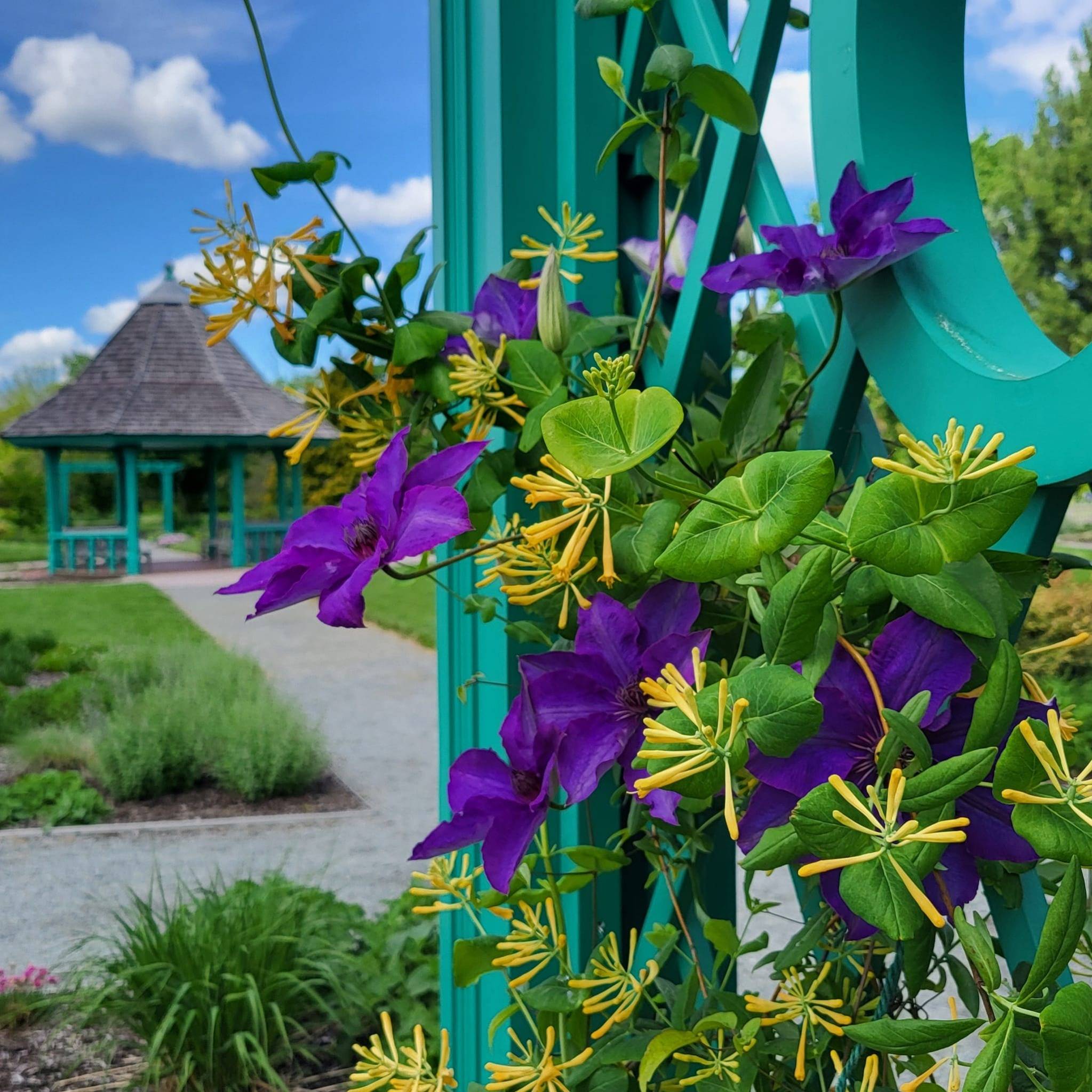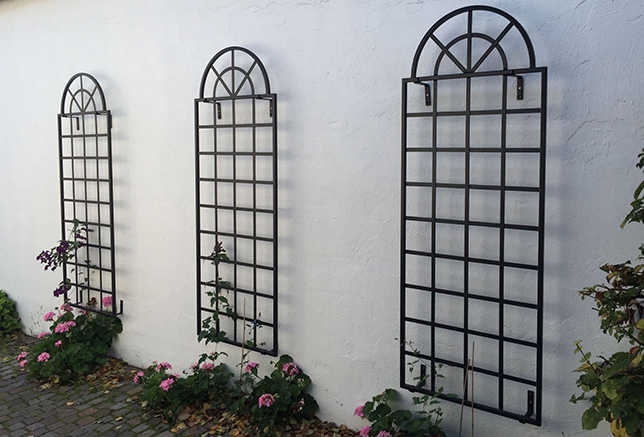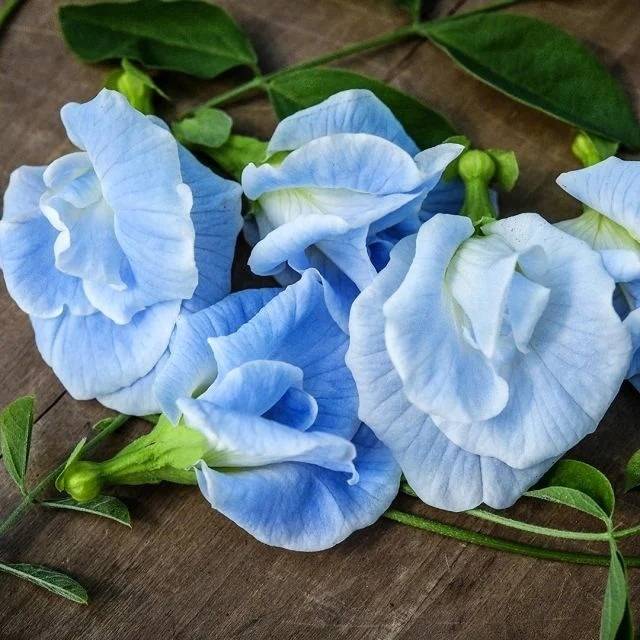
Growing Vines on Trellises and Obelisks
Wall trellises can be mounted on fences or exterior house walls. Growing vines on wall trellises not only beautifies a home's exterior, but can also provide a cooling effect in summer. Wall trellises can also be used in place of traditional fencing panels with the arches attached on either side to securely installed wooden fence posts. Evergreen vines provide year-round privacy in such situations, while annual flowering vines create seasonal privacy and spectacular color.
Planting a vine on a trellis or obelisk set directly into the garden adds often needed height and focus to a garden bed. A pathway can be punctuated with a repetition of trellised vines, a statue or fountain can be highlighted with a trellis set behind, or an upright trellis can create a welcoming element at an entrance.
Selecting a Climbing Vine
Selecting your vine, of course, depends on its intended use, location, soil adaptability and type of support. You would want to choose a dense, coarse foliage, possibly evergreen, if a screen is needed. A fine-textured, slow-growing vine would work well to add interest to a stone or brick wall. Fragrant vines are a wonderful addition near doorways, pathways and entertaining areas. Smaller-growing vines and annuals are better suited to container and balcony growing, while vigorous vines such as grapes or wisteria would require sizable supports. Be sure to match your chosen vine to an appropriately proportioned and sturdy trellis.
Types of Vines - Three Methods of Climbing
Vines possess various methods of climbing, which influences the type of support needed: tendrils, twining, clinging, or scrambling. Your selection of vine type and support must be compatible.
- Tendrils are slim, flexible leafless stems that wrap themselves around anything they contact. Clematis (leaf stems act as tendrils), passionvines, and grapes are examples of vines that climb by tendrils. Tendrilled vines will need supports such as wire, thin wood stakes, or trellises with bars up to about 3/4" in diameter.
- Twining vines, such as honeysuckle and wisteria, wind their stems around any available support. Twining vines climb best on trellis bars or posts less than 4 inches wide. Extremely vigorous vines like wisteria should have a minimum wooden post of 4x4", or a trellis or obelisk constructed of sturdy steel.
- Clinging vines, like Boston ivy, climb by attaching small root-like hold fasts to walls, trees or other rough-textured surfaces. Clinging vines can be used on either brick or masonry walls but should never be used on the walls of wooden buildings or shingled walls as they can cause damage. Others like climbing hydrangea, English Ivy and Wintercreeper climb via aerial rootlets, which can damage masonry and wood alike.
- Scramblers are basically plants that produce very long shoots that will "scramble" along the ground unless trained to a support, such as bouganvillea, climbing roses, and plumbago.

Vines for Trellises and Growing Tips
Hardy Vines
Common Name(Botanical Name) Zones | Image | HeightClimbing Method Growth Habits | Features | Siting & Growing |
|---|---|---|---|---|
Large Flowered Clematis (Clematis hybrids) Cultivar 'Crystal Fountain' shown
|  |
|
|
|
Trumpet Creeper (Campsis radicans)
|  |
|
|
|
Trumpet Creeper Hybrids (Campsis x tagliabuana)
|  |
|
|
|
Woodbine (Clematis virginiana)
|  |
|
|
|
Japanese Climbing Hydrangea (Schizophragma hydrangenoides) Cultivar 'Moonlight' shown* with silver overlay on green leaves
|  |
|
|
|
Climbing Hydrangea (Hydrangea anomala subsp. petiolaris)
|  |
|
|
|
Honeysuckle (Lonicera sempervirens - Native) Cultivar 'Major Wheeler' shown*
|  |
|
|
|
Carolina Jessamine (Gelsemium sempervirens)
Cultivar 'Margarita' shown*
|  |
|
|
|
Grape (Vitis spp.)
|  |
|
|
|
Dutchman's Pipe Aristolochia macrophylla and A. tomentosa (shown*)
|  |
|
|
|
Boston Ivy (Parthenocissus tricuspidata)
|  |
|
|
|
Virginia Creeper (Parthenocissus quinquefolia)
|  |
|
|
|
Maypop; Passionflower (Passiflora incarnata)
|  |
|
|
|
American Wisteria (Wisteria frutescens)
|  |
|
|
|
Cross Vine (Bignonia capreolata)
|  |
|
|
|
Kiwi Vine (Actinidia arguta & A. kolomikta)
|  |
|
|
|
Annual Vines
Common Name(Botanical Name) Zones | Image | HeightClimbing Method Growth Habits | Features | Siting & Growing |
|---|---|---|---|---|
Moonflower (Ipomoea alba) |  |
|
|
|
Morning Glory (Ipomoea purpurea) |  |
|
|
|
Sweet Peas (Lathyrus odoratus) |  |
|
|
|
Scarlet Runner Bean (Phaseolus coccineus)
|  |
|
|
|
Black Eyed Susan Vine (Thunbergia alata)
|  |
|
|
|
Cup and Saucer Vine (Cobaea scandens)
|  |
|
|
|
Spanish Flag (Mina lobata, Ipomoea lobata)
|  |
|
|
|
Hyacinth Bean Vine (Dolichos lablab; Lablab purpureus)
|  |
|
|
|
Cypress Vine & Cardinal Climber (Ipomoea quamoclit and I. x mulitifida, I. x sloteri)
(Cardinal climber shown) |  |
|
|
|
Purple Bell Vine (Rhodochiton atrosanguineum)
|  |
|
|
|
Tropical Vines
Common Name(Botanical Name) Zones | Image | HeightClimbing Method Growth Habits | Features | Siting & Growing |
|---|---|---|---|---|
Mandevilla and Dipladenia
|  |
|
|
|
Bougainvillea
|  |
|
|
|
Sky Vine, Clock Vine (Thunbergia grandiflora)
Photo courtesy Unsplash |  |
|
|
|
Cape Leadwort (Plumbago auriculata)
|  |
|
|
|
Passionflower (Passiflora spp.) P. coccinea Zones 10-11 'Lady Margaret' shown, photo courtesy Top Tropicals Inc., www.toptropicals.com |  |
|
|
|
Golden Trumpet Vine, Brown Bud Allamanda (Allamanda cathartica var. hendersonii)
|  |
|
|
|
Confederate Jasmine, Star Jasmine (Trachelospermum jasminoides)
|  |
|
|
|
**Photos courtesy US Perennials, www.usperennials.com - Native Plant Specialist Grower
Climbing Vines to Avoid Planting in Your Garden
The below list includes vines that have been declared invasive in at least one state in the US. Alternatives are listed here as well.
- Wisteria, Chinese and Japanese: Just no reason to plant this. Native Wisteria frustescens is more appropriate in size for most uses, being half the enormous mature size of the others. It still grows quickly and needs a sizeable, sturdy support, however. The flowers are equally attractive, and cultivars in white and different shades of blue or purple are available. Blooming is on new wood, so a bit later than the invasive species and with the leaves. This does make the timing of pruning much easier (when dormant), and can also be pruned as needed after blooming to control size without worrying about removing flower buds.
- Honeysuckle, Japanese: Native species and cultivars are just as attractive, although most are not fragrant. Hybrids and native cultivars are also more restrained and better suited to typical garden situtations.
- Chocolate Vine (Akebia quinata): Planted for its unique chocolate scented dark purple-maroon flowers, but the vigorous (up to 40') growth and ability to withstand full sun, shade, and various soil conditions are problematic. It creates mats of foliage that can smother other plants, and has been deemed invasive in some areas. Native honeysuckle would be a good substitute, or annual moonflower if fragrance is desired.
- English Ivy (Hedera helix): At its worst when allowed to climb, as it rarely flowers when not growing upward. Seeds formed after blooming are dispersed widely by birds, spreading everywhere. Unfortunately, there is not a substitute reliably evergreen climber for zones above 6-7. Where privacy is desired in northerly space-restricted locations, consider planting narrow upright evergreen varieties of arborvitae, juniper, or Japanese holly. Climbing hydrangea and Japanese climbing hydrangea are deciduous but have similar growth habits and offer attractive flowers and winter bark as well.
- Sweet Autumn Clematis (Clematis terniflora): Again, no reason to plant this, as native Clematis virginiana is the preferred choice and grows and looks very similar.















